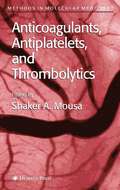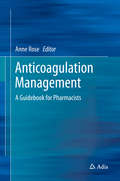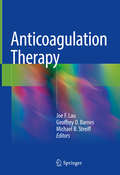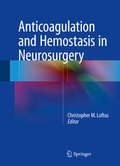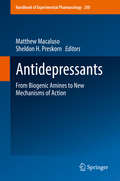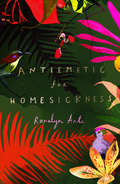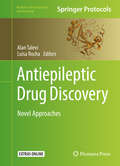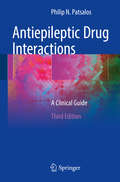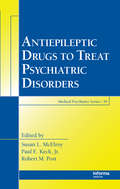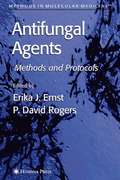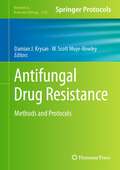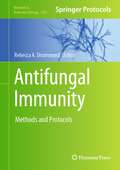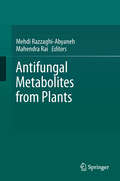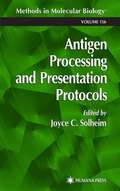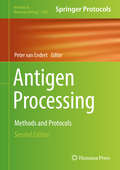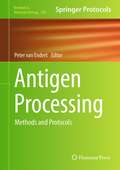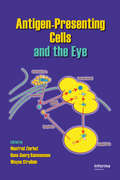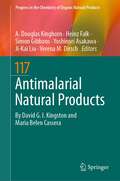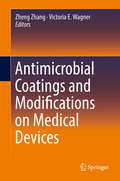- Table View
- List View
Anticoagulants, Antiplatelets, and Thrombolytics: Methods And Protocols (Methods in Molecular Medicine #93)
by Shaker A. Mousa1This collection of review articles highlights the latest development of antithrombotics and provides proven experimental methods for the further development of new and improved anticoagulants. Among the cutting-edge developments reviewed are the novel usage of low molecular weight heparins, such antithrombin agents as the hirudin, and such antiplatelet drugs as the GPIIb/IIIa inhibitors and ADP receptor antagonists. Additional innovations discussed include aspirin and clopidogrel, the expanded use of polytherapeutic approaches, antiproteases (factors IIa, Xa, and VIIa), tissue factor targeting, platelet receptor targeting, and antithrombin III modulation.
Anticoagulation Management: A Guidebook for Pharmacists
by Anne RoseIn addition to acting as a training guide for pharmacists, pharmacy residents and pharmacy students who seek to practice in areas associated with patients on anticoagulant therapy, the information presented within highlights the growing role of the pharmacist in these contexts. Readers will find useful information on anticoagulant management across all pharmacy practice areas, including the inpatient, ambulatory, emergency services and transitions of care settings. Particular attention is given to summarizing best practices and providing 'real world' examples of ways in which pharmacists can be involved in anticoagulation management and the impact of such involvement. In the first major section of the book, each chapter focuses on the role of the pharmacist in the management of medication with a specific type of anticoagulants (e. g. warfarin, heparin and target-specific oral agents) in various healthcare settings. A broader overview of the clinical management of anticoagulation therapy is provided in the second major section, including descriptions of the role of pharmacists in assessing venous thromboembolism risk, ensuring patients receive appropriate prophylactic therapy, and monitoring outcomes.
Anticoagulation Therapy
by Joe F. Lau Geoffrey D. Barnes Michael B. StreiffThis book presents the latest evidence and guidelines supporting the use of anticoagulant therapy for various clinical scenarios. The field of anticoagulation therapy is evolving rapidly, particularly since the arrival and widespread adoption of direct oral anticoagulants. Organized in two parts, this book reviews the pharmacologic properties of various anticoagulants and details the clinical applications of anticoagulant therapy. Drugs such as warfarin and unfractionated heparin, as well as parenteral and direct oral anticoagulants are discussed in terms of their pharmacokinetics, drug-disease interactions, dosing strategies, and risk considerations. Clinical applications of anticoagulant therapy in disorders such as acute coronary syndromes, atrial fibrillation, and thrombophilia and in special populations such as pregnant women, the elderly, and in the patient with cancer are highlighted. Clinical vignettes, algorithms, clinical pearls, and self-assessment questions are integrated throughout the book. Featuring contributions from authorities in the field, Anticoagulation Therapy is an essential resource for cardiologists, vascular medicine specialists, hematologists, internists, and all other healthcare professionals who prescribe anticoagulants.
Anticoagulation and Hemostasis in Neurosurgery
by Christopher M. LoftusThis book is an up-to-date reference on all aspects of anticoagulation and hemostasis in neurosurgery. After an opening section on basic principles and drug classes in current use, detailed consideration is given to coagulation issues relevant to all patients, not just neurosurgical ones. The coverage includes, for example, deep vein thrombosis, pulmonary embolism, and disseminated intravascular coagulation. A variety of important issues specific to neurosurgical practice are then addressed, and a summary of current guidelines and best practices is provided. By bringing together the latest knowledge from across the discipline, this book will serve as a sound basis for informed decision making in surgical practice. It will be of daily value for neurosurgeons and trainees worldwide and will also be of interest to emergency room physicians, surgeons in general, critical care physicians, neurologists, and hospital medicine specialists.
Antidepressants
by Stephen M. StahlAll of the titles in the Stahl's Illustrated Series are designed to be fun. Concepts are illustrated by full-color images that will be familiar to all readers of Stahl's Essential Psychopharmacology, Third Edition and The Prescriber's Guide. The texts in this user-friendly series can be supplements to figures, images, and tables. The visual learner will find that these books make psychopharmacology concepts easy to master, while the non-visual learner will enjoy a shortened text version of complex psychopharmacology concepts. Within each book, each chapter builds on previous chapters, synthesizing information from basic biology and diagnostics to building treatment plans and dealing with complications and comorbidities. Novices may want to approach Stahl's Illustrated Series by first looking through all the graphics and gaining a feel for the visual vocabulary. Readers more familiar with these topics should find that going back and forth between images and text provides an interaction with which to vividly conceptualize complex pharmacologies. And, to help guide the reader toward more in-depth learning about particular concepts, each book ends with a Suggested Reading section.
Antidepressants: From Biogenic Amine To New Mechanisms Of Action (Handbook of Experimental Pharmacology #250)
by Matthew Macaluso Sheldon H. PreskornThis volume reviews the known neurobiology of depression and combines classic data on antidepressant treatments with modern theory on the physiology of depression. It also discusses novel mechanism of action drugs.
Antiemetic for Homesickness
by Romalyn Ante*Longlisted for the Swansea University Dylan Thomas prize 2021**Shortlisted for the Jhalak Prize 2021: A 'tour-de-force'**An Irish Times and Poetry School Book of the Year 2020*'A day will come when you won't missthe country na nagluwal sa 'yo.'- 'Antiemetic for Homesickness'The poems in Romalyn Ante's luminous debut build a bridge between two worlds: journeying from the country 'na nagluwal sa 'yo' - that gave birth to you - to a new life in the United Kingdom. Steeped in the richness of Filipino folklore, and studded with Tagalog, these poems speak of the ache of assimilation and the complexities of belonging, telling the stories of generations of migrants who find exile through employment - through the voices of the mothers who leave and the children who are left behind. With dazzling formal dexterity and emotional resonance, this expansive debut offers a unique perspective on family, colonialism, homeland and heritage: from the countries we carry with us, to the places we call home.'Moving, witty and agile' Observer'By turns playful and tender, offering a formally-various exploration of migration, community, and nursing... there is honesty, musicality, a powerful heart' Irish Times
Antiepileptic Drug Discovery: Novel Approaches (Methods in Pharmacology and Toxicology)
by Luisa Rocha Alan TaleviThis thorough volume delves into antiepileptic drug discovery with a comprehensive collection of innovative approaches for the development of antiepileptic therapies, focusing on novel molecular targets for antiepileptic drugs, computer-aided approaches for the identification of new drug candidates, and therapeutic strategies to overcome refractory epilepsy. The last section illustrates the potential benefits that network pharmacology and rational drug repurposing could bring to the antiepileptic drug discovery community. Written for the "Methods in Pharmacology and Toxicology" series, chapters include the kind of detailed description and implementation advice to ensure results in the laboratory. Authoritative and practical, "Antiepileptic Drug Discovery: Novel Approaches" aims to provide medicinal chemists, pharmacologists, and other researchers with the tools need to further explore the study of pharmacoresistant epilepsy and the discovery of new antiepileptic drugs.
Antiepileptic Drug Interactions, Second Edition: A Clinical Guide
by Philip PatsalosAntiepileptic Drug Interactions: A Clinical Guide, Second Edition provides a pocket-sized, systematic description of the most clinically relevant drug interactions that occur between AEDs and also between AEDs and non-AEDs. AEDs are presented alphabetically and by drug class in three sections for easy access: Drug interactions between AEDs; Drug interactions between AEDs and non-AEDs: Interactions affecting AEDs; and Drug interactions between AEDs and non-AEDs: Interactions affected by AEDs. Antiepileptic Drug Interactions: A Clinical Guide, Second Edition should help physicians make more rational choices when polytherapy regimens are indicated and should be of interest to all who treat patients with epilepsy: neurologists and neurosurgeons, trainees at all levels, general practitioners and epilepsy nurse specialists.
Antiepileptic Drug Interactions, Third Edition: A Clinical Guide
by Philip N. PatsalosThis updated third edition of a successful book is a description of both pharmacokinetic and pharmacodynamic antiepileptic drug (AED) interactions, including details of the magnitude and mechanism of interactions, and also of drug combinations that are not associated with interactions and therefore can be coprescribed without undue concern. Presented in alphabetical order and by drug class, drug interactions that occur between AEDs and also between AEDs and non-AEDs are described in three sections: Drug interactions between AEDs; Drug interactions between AEDs and non-AED Drugs: Interactions affecting AEDs; Drug interactions between AEDs and non-AED Drugs: Interactions affected by AEDs. Antiepileptic Drug Interactions: A Clinical Guide, 3rd Edition with its clear, concise and unambiguous content will allow physicians and allied health professionals to make more rational choices when AED polytherapy regimens are indicated. There is always a choice and avoiding highly interacting drugs and choosing drug combinations that are minimally interacting or do not interact should be the goal in treating patients with epilepsy. This book provides all the necessary information so as to allow this goal to be achieved and, if necessary, to aid effective management of AED interactions.
Antiepileptic Drugs and Pregnancy: A Guide for Prescribers
by Mj Eadie Fje VajdaA description of our current understanding of antiepileptic drug use during pregnancy, this book includes chapters on the impact of seizures on the mother and developing child, changes in maternal physiology during pregnancy and its impact on drug disposition, and the pharmacokinetic differences between the various anti-seizure medications. It also deals with the possible harmful effects of antiepileptic drug exposure during pregnancy on the physical and intellectual development of the fetus. Clinicians have to balance the potential adverse effects of the medicine for the fetus and mother-to-be against the risks that uncontrolled seizures hold for both when treating pregnant women with antiepileptic drugs. Only recently have enough scientific data emerged to provide a rational basis for treatment decisions that take in both aspects. This work provides a single, accessible and up-to-date resource for busy clinicians.
Antiepileptic Drugs to Treat Psychiatric Disorders (Medical Psychiatry Series)
by Susan L. McElroy Robert M. Post Paul E. KeckSeveral antiepileptic drugs (AEDs) now have regulatory indications for treating bipolar disorder. There is growing evidence that AEDs in general have a variety of useful psychotropic effects. Antiepileptic Drugs to Treat Psychiatric Disorders is the first comprehensive, clinically oriented reference on the use of AEDs to treat a variety of psychiat
Antifungal Agents: Methods And Protocols (Methods in Molecular Medicine #118)
by Erika J. ErnstA collection of state-of-the-art molecular methods for studying antifungal resistance, for discovering and evaluating both new and existing antifungal drugs, and for understanding the host response and immunotherapy of such agents. The protocols follow the successful Methods in Molecular MedicineTM series format, each offering step-by-step laboratory instructions, an introduction outlining the principle behind the technique, lists of the necessary equipment and reagents, and tips on troubleshooting and avoiding known pitfalls. Antifungal Agents: Methods and Protocols offers clinician-scientists, microbiologists and molecular biologists the productive tools they need today to understand and successfully develop new therapeutic agents for yeast, mold, and fungal infections.
Antifungal Drug Resistance: Methods and Protocols (Methods in Molecular Biology #2658)
by Damian J. Krysan W. Scott Moye-RowleyThis detailed volume aims to elucidate the molecular mechanisms that underlie antifungal resistance. The book highlights methods to identify and characterize antifungal activity, to define and characterize strains with altered responses to antifungal drugs, to investigate the genetic and molecular mechanisms of these alterations of antifungal drug susceptibility, and, finally, to approach the study of these processes in animal models of fungal infection. Written for the highly successful Methods in Molecular Biology series, chapters include introductions to their respective topics, lists of the necessary materials and reagents, step-by-step and readily reproducible laboratory protocols, as well as tips on troubleshooting and avoiding known pitfalls. Authoritative and practical, Antifungal Drug Resistance: Methods and Protocols serves as an ideal resource for the field and a guide for investigators to study this important translational aspect of fungal biology.
Antifungal Immunity: Methods and Protocols (Methods in Molecular Biology #2667)
by Rebecca A. DrummondThis volume aims to help new investigators to the field by providing them with the protocols needed to set up clinically relevant animal models of fungal infection, as well as methods for in vivo immunology.Written in the format of the highly successful Methods in Molecular Biology series, each chapter includes an introduction to the topic, lists necessary materials and methods, includes tips on troubleshooting and known pitfalls, and step-by-step, readily reproducible protocols. Authoritative and cutting-edge, Antifungal Immunity: Methods and Protocols aims to be comprehensive guide for researchers in the field
Antifungal Metabolites from Plants
by Mahendra Rai Mehdi Razzaghi-AbyanehThe goal of this book is to provide essential information on the use of different medicinal plants and their secondary metabolites for the treatment of various fungal diseases affecting human beings, animals and plants. It is divided in four parts: Part I examines the global distribution of plant-derived antifungal compounds, Part II deals with antifungal activities of plant metabolites, Part III includes plants used in Ayurveda and traditional systems for treating fungal diseases, and Part IV discusses the use of plant-derived products to protect plants against fungal diseases.
Antifungal Therapy, Second Edition
by Mahmoud A. Ghannoum John R. PerfectThis new edition of Antifungal Therapy aims at providing concise, practical, need-to-know information for busy physicians dealing with fungal infections, such as infectious disease physicians, transplant surgeons, dermatologists, and intensivists, as well as basic scientists and pharmaceutical company researchers interested in the state of antifungal therapy. It provides a comprehensive, up-to-date overview of the pertinent issues pertaining to antifungal treatment including the basics of clinical mycology, management insights for various infections, evidence-based treatment recommendations, and helpful tables summarizing currently available pharmacokinetics data. Key Features • Features useful information on administration, dosage and pharmacology of antifungal drugs that can be difficult to use in clinical practice • Contains common Clinical Questions & Answers to highlight frequently encountered patient issues • Covers clinical mycology essentials in addition to antifungal treatment to create a well-rounded reference • Presents illustrations and clinical photos in full color to elucidate the concepts • Provides detailed evidence of treatment recommendations
Antigen Processing and Presentation Protocols (Methods in Molecular Biology #156)
by Joyce C. SolheimWell-recognized and innovative experimentalists detail their cutting-edge methods for studying the antigen processing and presentation. Drawing on expertise from biochemistry, cell biology, and immunology, they describe step-by-step methods designed to question how MHC-binding peptides are generated, to test how peptides are delivered to MHC molecules, to analyze MHC peptide-binding patterns, and to assay the T-cell response to the MHC/peptide complex. Emphasis is given those technical steps critical for experimental success that are often omitted from methods published in the primary literature. Eminently accessible and state-of-the-art, Antigen Processing and Presentation Protocols provides both new and experienced investigators with highly practical tools that will extend the questions that can be asked, and effectively be answered, concerning antigen processing/presentation.
Antigen Processing: Methods and Protocols (Methods in Molecular Biology #1988)
by Peter Van EndertThe second edition volume expands on the previous edition with new and updated chapters on the latest methods used for studying presentation of antigenic peptides produced in the standard processing pathways for MHC class I and II molecules. The new chapters cover topics such as biochemical and cellular approaches to study the impact of the endoplasmic reticulum aminopeptidases; techniques to monitor MHC class I synthesis and degradation; approaches to measure processing efficacy; description of different assays measuring MHC recycling; and protocols to produce MHC class II tetramers. Written in the highly successful Methods in Molecular Biology series format, chapters include introductions to their respective topics, lists of the necessary materials and reagents, step-by-step, readily reproducible laboratory protocols, and tips on troubleshooting and avoiding known pitfalls. Cutting-edge and comprehensive, Antigen Processing: Methods and Protocols, Second Edition is a valuable tool for both novice and expert researchers interested in studying antigen processing and venturing out further into this evolving field.
Antigen Processing: Methods and Protocols (Methods in Molecular Biology #960)
by Peter Van EndertThis Methods in Molecular BiologyTM book offers a comprehensive set of protocols for studying presentation of antigens produced in the standard processing pathways for MHC class I and class II molecules. Includes materials lists, tips and troubleshooting advice.
Antigen-Presenting Cells and the Eye
by Hans-Georg Rammensee Manfred Zierhut J. Wayne StreileinIn recent years the importance of antigen-presenting cells and their influence on the eyes has been elucidated. We have learned that nearly every structure of the eye harbors these cells, yet they differ in their activities and thus in the ways in which they protect against - or participate in - diseases of the eye. Antigen-Presenting Cells and the
Antikörper in der Krebsbekämpfung: Grundlagen, Prinzipien und Anwendungsmöglichkeiten
by Melvyn LittleAntikörper als biologische Waffe gegen den Krebs Ein Buch über Historie, Entwicklung und den spannenden Einsatz von Antikörpern zur Behandlung von Krebs. Der Autor versteht es, für interessierte Fachleute, Ärzte und Laien die Grundlagen dieser neuen Technologie auf leicht verständliche Weise zu vermitteln und die wesentlichen Prinzipien unkompliziert darzustellen. Einfache und übersichtliche Abbildungen und Tabellen ermöglichen es dem Leser, die wesentlichen Informationen des Buches rasch zu erfassen. Antikörper machen heute einen großen Teil des Umsatzes für biologische Produkte in der Pharmabranche aus und ihre Bedeutung in der Krebstherapie nimmt ständig zu. Der Inhalt Aufbau, Eigenschaften und Herstellung von Antikörpern Impfung als Krebsprävention - Herstellung von Tumorvakzinen Therapeutische Antikörper zur Behandlung verschiedener Krebserkrankungen Wirkungsweise und Verwendung zugelassener Antikörper Therapeutische Antikörper als schnell wachsende Sparte biopharmazeutischer Produkte Antikörper in klinischer Entwicklung - Ausblick in die Zukunft Der Autor Prof. Melvyn Little, ehemaliger Leiter der Forschungsgruppe ,,Rekombinante Antikörper" am Deutschen Krebsforschungszentrum in Heidelberg und außerplanmäßiger Professor für Biochemie an der Universität Heidelberg. Mitbegründer der Biotech-Firma Affitech in Oslo. Gründer und Vorstandsmitglied der Biotech-Firma Affimed Therapeutics in Heidelberg. Heute im Ruhestand und Biotechnologie-Consultant.
Antimalarial Natural Products (Progress in the Chemistry of Organic Natural Products #117)
by A. Douglas Kinghorn Heinz Falk Simon Gibbons Yoshinori Asakawa Ji-Kai Liu Verena M. DirschThis volume begins with a short history of malaria and follows with a summary of its biology. It then traces the fascinating history of the discovery of quinine for malaria treatment, and then describes quinine’s biosynthesis, its mechanism of action, and its clinical use, concluding with a discussion of synthetic antimalarial agents based on quinine’s structure. It also covers the discovery of artemisinin and its development as the source of the most effective current antimalarial drug, including summaries of its synthesis and biosynthesis, its mechanism of action, and its clinical use and resistance. A short discussion of other clinically used antimalarial natural products leads to a detailed treatment of additional natural products with significant antiplasmodial activity, classified by compound type. Although the search for new antimalarial natural products from Nature’s combinatorial library is challenging, it is very likely to yield new antimalarial drugs. This book thus ends by identifying ten natural products with development potential as clinical antimalarial agents.
Antimicrobial Coatings and Modifications on Medical Devices
by Zheng Zhang Victoria E. WagnerBased on a fundamental understanding of the interaction between bacteria and materials, this timely volume emphasizes the latest research in the antimicrobial interfacial design and provides an invaluable blueprint for improving antimicrobial performance on devices and products. Antimicrobial Coatings and Modifications targets reduction of microbial accumulation on biomedical and industrial materials through changing interfacial characteristics. Applying a viable antimicrobial coating or modification to resist alarming threats is a highly demanding requirement for many medical and engineering applications. Many contemporary books in the area of antimicrobial solution focus on applying antimicrobial agents or materials that can kill bacteria. The volume pays more attention to eliminating bacterial contamination and biofilm formation through surface characteristics with minimized bacterial resistance and environmental impact.
Antimicrobial Compounds: Current Strategies and New Alternatives
by Tomás G. Villa Patricia Veiga-CrespoSince penicillin and salvarsan were discovered, a number of new drugs to combat infectious diseases have been developed, but at the same time, the number of multi-resistant microorganism strains is increasing. Thus, the design of new and effective antibacterial, antiviral and antifungal agents will be a major challenge in the next years. This book reviews the current state-of-the-art in antimicrobial research and discusses new strategies for the design and discovery of novel therapies. Topics covered include the use of genetic engineering, genome mining, manipulation of gene clusters, X-ray and neutron scattering as well as the antimicrobial effects of essential oils, antimicrobial agents of plant origin, beta-lactam antibiotics, antimicrobial peptides, and cell-wall-affecting antifungal antibiotics.
